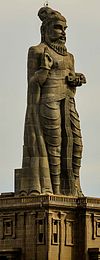Paridhi
Paridhi (c. 11th century CE), also referred to as Paridhiyaar, was a
Early life
Paridhi is also referred to as Parudhi in olden manuscripts.
Similar to the commentaries by Kaalingar, Pariperumal, and Mallar, Paridhi's commentary is believed to have been originated in the Kongu Region.[7]
Religion
Paridhi belonged to the Saivite sect.
Commentary on the Kural text
Of all the ten medieval commentaries of the Kural text, Paridhi's commentary is the simplest in form and presentation. The commentary appears more or less in a colloquial style, without losing the beauty of the language and ease of comprehension.
For Kural couplets 161, 166, 167, 191, and 194, Paridhi's commentary is similar in meaning to that of Kaalingar. For couplet 1126, it strikes a similarity with that of Parimelalhagar.
Variations in ordering of the Kural verses
The following table depicts the variations among the early commentators in ordering, for example, the first ten verses of the Tirukkural. Note that the ordering of the verses and chapters as set by Parimelalhagar, which had been followed unanimously for centuries ever since, has now been accepted as the standard structure of the Kural text.
| Kural verse beginning | Couplet ordering | ||||
|---|---|---|---|---|---|
| Manakkudavar's | Pari Perumal's | Paridhi's | Kaalingar's | Parimelalhagar's | |
| Kural 1: அகர முதல எழுத்தெல்லாம் | 1 | 1 | 1 | 1 | 1 |
| Kural 2: கற்றதனால் ஆய பயன் | 2 | 2 | 2 | 2 | 2 |
| Kural 3: மலர்மிசை ஏகினான் மாணடி | 3 | 3 | 3 | 3 | 3 |
| Kural 4: வேண்டுதல் வேண்டாமை இலான் | 6 | 6 | 5 | 7 | 4 |
| Kural 5: இருள்சேர் இருவினையும் சேரா | 7 | 7 | 6 | 6 | 5 |
| Kural 6: பொறிவாயில் ஐந்தவித்தான் | 8 | 8 | 7 | 7 | 6 |
| Kural 7: தனக்கு உவமை இல்லாதான் | 4 | 4 | 6 | 4 | 7 |
| Kural 8: அற ஆழி அந்தணன் | 5 | 5 | 10 | 9 | 8 |
| Kural 9: கோளில் பொறியில் குணமிலவே | 10 | 10 | 8 | 5 | 9 |
| Kural 10: பிறவிப் பெருங்கடல் நீந்துவர் | 9 | 9 | 9 | 10 | 10 |
Comparing the verse ordering by various ancient commentators with that of Manakkudavar, the first of the ancient commentators whose commentary is available, it can be reckoned that Paridhi's commentary follows closely Manakkudavar's, save for a few variations. The modern chapters 10, 13, 17, 18, and 19 appearing under the subsection "Domestic virtues" of the Kural text appear as chapters 26, 27, 30, 31, and 32, respectively, under the subsection "Ascetic virtues" in Manakkudavar's commentary. Similarly, the modern chapters 26, 29, 30, 31, 32, 33, appearing under the subsection "Ascetic virtues" appear as chapters 19, 20, 10, 16, 17, 18, respectively, under the subsection "Domestic virtues" in Manakkudavar's work. Nevertheless, being the earliest available commentary of the Tirukkural, Manakkudavar's work is considered to bear the closest semblance with the original work of the Kural text by
The following table shows the numbering of variations found in the ordering of the Kural verses by various ancient commentators with respect to the commentary by Manakkudavar.
| Commentator | Number of variations in verse ordering |
|---|---|
| Pari Perumal | 16 |
| Paridhi | 20 |
| Kaalingar | 171 |
| Parimelalhagar | 120 |
Publication
According to M. V. Aravindan, Paridhi's commentary was first published in 1935.[4] S. Meiyappan records that the commentary was published again in 1938 by Thudisai Kilar.[4] C. Dandapani Desikar, who published Tirukkural Uraivalam, a compendium of early Kural commentaries including that of Paridhi, said that the palm-leaf manuscript for Paridhi's commentary was provided by V. R. Deivasikamani Goundar.[4]: 9 In his compendium on the Kamatthuppal (Book III of the Kural text), Desikar has analyzed the history of Paridhi, Manakkudavar, Parimelalhagar, Kaalingar, and Pari Perumal and the nature of their commentaries.[11] Paridhi's commentary is unavailable for 22 couplets.[4] Of the available commentaries for the remaining 1308 couplets, the commentary differs from other medieval commentaries in 21 places.[4]
Other works
Following the
See also
Citations
- ^ Vedhanayagam, 2017, pp. 7–8.
- ^ Natarajan, 2008, pp. 1–6.
- ^ a b c d e Sundaramurthi, 2006, p. 176.
- ^ ISBN 978-81-91003-00-0.
- ^ a b Desikar, C. Dhandapani (2012). திருக்குறள் அழகும் அமைப்பும் [Tirukkural: Beauty and Structure] (in Tamil). Chennai: Tamil Valarchi Iyakkagam. p. 138.
- ^ a b c d e f M. V. Aravindan (2018). உரையாசிரியர்கள் [Commentators]. Chennai: Manivasagar Padhippagam. pp. 348–360.
- ^ Pulavar S. Raju, The Hindu, 23 June 2010.
- ^ Sundaramurthi, 2006, p. 177.
- ^ a b Chellammal, 2015, p. 147.
- ^ Sundaramurthi, 2006, pp. 176–177.
- ^ Kalpana Sekkizhar, 2009, p. 37.
References
- Vedhanayagam, Rama (2017). திருவள்ளுவ மாலை மூலமும் எளிய உரை விளக்கமும் [Tiruvalluvamaalai: Moolamum Eliya Urai Vilakkamum] (in Tamil) (1st ed.). Chennai: Manimekalai Prasuram. pp. 7–8.
- Natarajan, P. R. (December 2008). Thirukkural: Aratthuppaal (in Tamil) (1st ed.). Chennai: Uma Padhippagam. pp. 1–6.
- Chellammal, G. P. (2015). திருக்குறள் ஆய்வுக் கோவை [Tirukkural Research Compendium] (in Tamil) (1st ed.). Chennai: Manivasagar Padhippagam.
- I. Sundaramurthi (2006). பரிமேலழகர் திருக்குறள் உரைத்திறன் [Critical Analysis of Parimelalhagar's Tirukkural Commentary] (in Tamil) (1st ed.). Chennai: Meyyappan Padhippagam.
- S. Raju, Pulavar (23 June 2010). "Kongu region's role in development of Tamil". The Hindu. Retrieved 23 January 2025.
- Sekkizhar, Kalpana (2009). திருக்குறள் பரிதியார் உரைத்திறன் [Critical Analysis of Paridhi's Tirukkural Commentary]. Chennai: Tamilmann Padhippagam. p. 208. ISBN 978-93-6153-543-7.
Further reading
- M. Arunachalam (2005). Tamil Ilakkiya Varalaru, Padhinaindhaam Nootraandu [History of Tamil Literature, 15th century].
- D. M. Vellaivaaranam (1983). Tirukkural Uraikotthu. Thiruppananthal Shri Kasimadam Publications.
- Desikar, S. Dhandapani (2003). Tirukkural Urai Kalanjiyam. Madurai: Madurai Kamaraj University Press. p. 217.

